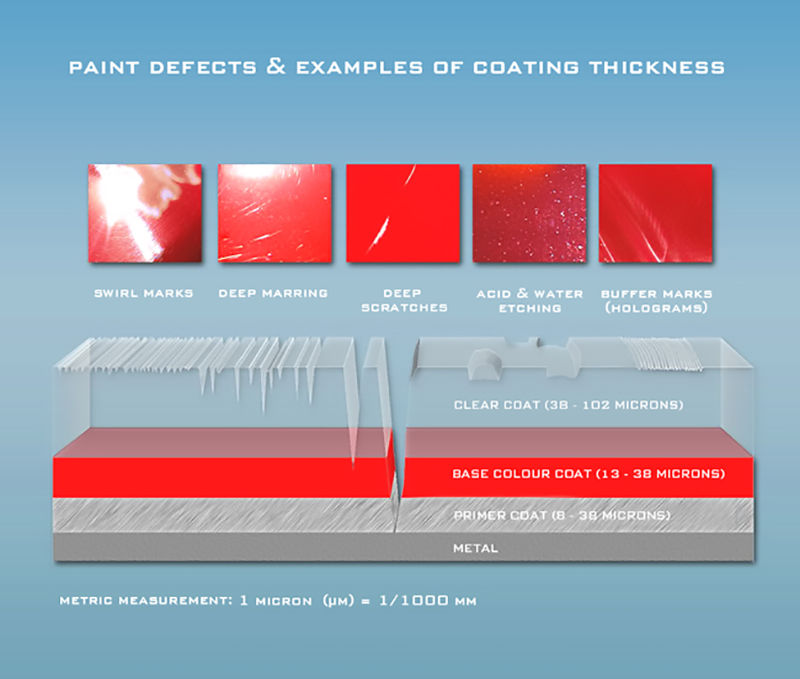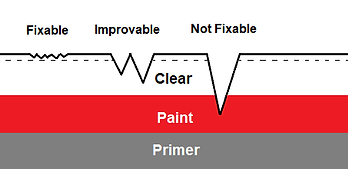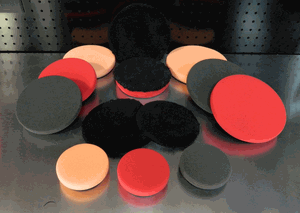detailing advice on selecting paint detailing products
What are you trying to accomplish?
Removing Paint Contaminants
TIP
Not all contaminants that bind to your paint are visible to the naked eye. To get the best results from any final wax, coating etc. do the simple "baggie test". Take a plastic bag (grocery bags work great) and run your fingers over the paint. If it feels rough it is contaminated & doing a clay bar type treatment on the paint will make your wax or coating look better & last longer.

Chemical Contaminant Removal
What do you need to remove?
Mechanical Contaminant Removal
Mechanical removal of paint contaminants involves clay barring the surface. There are 2 types of clay bars. Conventional clay & synthetic clay.
TIP
There is no right or wrong answer regarding which of the 2 types of clay is best. Synthetic clay lasts longer and no separate lubricant is needed so this type is very economical. Conventional clay tends to give a bit more "deep cleaning". For regular maintenance synthetic clay may be the best choice. If you are clay barring before applying a long lasting coating you may to to a conventional clay bar treatment to get your paint as clean as possible. Note: Clay will remove surface contaminants only. Scratches, etched water spots etc. are unaffected by any type of clay bar treatment.
Conventional Clay
A clay bar is a malleable bar (almost like putty) that with a clay lubricant you rub over the paint surface. Contaminants become trapped in the clay as you rub the clay over your paint. There are a number of kits available that include everything you need to clay bar your car or you can purchase the clay & lube separately.

Synthetic Clay
Synthetic Clay has a polymerized rubber surface that you rub over the paint. As you do contaminants are broken away. You get more uses out of synthetic clay & no special lubricant is required (regular car wash soap works great)


Below Surface Defect Removal
The most common type of below the surface defects on your car paint are scratches or "swirl marks". However there are numerous other defects that can occur (see below) that will require what is commonly known as "paint polishing" to remove. Car polishing or "buffing" or "paint correction" is the process of mechanically removing paint defects by removing a thin layer of your paints clearcoat (top layer of paint) in order to remove the defect(s). This process is done using a combination of pad and an abrasive polish and either by hand or machine mechanically removing the defects. If your vehicle paint has a lot of defects although it is possible to remove by hand the process will be very time consuming and using a machine polisher is recommended. If you elect to machine polish your car unless you are an experienced polisher it is strongly recommended that you use a "Dual Action" (D/A) type polisher (as opposed to a rotary style machine) Dual action polishers are very safe and easy to use and give great results. For more information on car polishing please see our blog or attend one of our free polishing seminars.

TIP
As a general rule any scratch that you can feel with your fingernail is too deep to be safely removed by any type of polishing process.

Paint Protection
TIP
In addition to protecting your paint from the elements the products below are also designed to enhance the paint's gloss, shine & hydrophobic qualities. Keep in mind that the results you will get in this area will only be as good as the surface they are applied to. The cleaner and more defect free your paint is before applying your product the better the results will be.
There a number of factors involved in selecting the right paint protection for you. There are 4 basic categories of products. Understanding the basic features of each will help you select the right product to meet your needs...
-
WAX - Waxes come in spray, liquid and paste versions. They are very easy to apply. Waxes sit on the surface of your paint. Wax products will provide a good shine to your paint but are not very durable. Even the best quality waxes will only last 3 -4 months. They can be a great solution for summer only driven cars but are perhaps not the best choice if you are looking to protect your paint in the harsh winter months.
-
SEALANTS - Paint sealants contain polymers. The polymers actually bond to the paint creating a harder shell. Sealants come in liquid form and are applied in a very similar way to a liquid wax. Because of the polymers sealants are more durable than waxes & provide protection from the elements. Sealants last anywhere from 6 - 12 months. If your paint has metallic flakes a sealant will make the flakes "pop" a bit more than wax
-
COATINGS - The most common type of coating on the market are Ceramic Coatings (although there are also coatings now available that contain Graphene) These ceramic coatings contain Si02 particles (tiny particles of glass). These particles bond to the paint surface giving a very durable surface that is highly reflective and slick which gives great water beading. Ceramic products have by far the best chemical resistance (best protection from bird droppings, tree sap etc.). Because of the slickness of the surface, ceramic coated vehicles are easier to clean. Most DIY ceramic coatings have a durability of 2-3 years. Although not a great level of skill is required to apply a 2 year coating on your vehicle, they are a bit more time consuming to apply than a wax or sealant. Another important factor to consider is that paint preparation is very important. You should clay bar the vehicle & use a wax/polish remover product before applying your coating to ensure your paint is contaminate free. Applying the coating to a clean surface allows the coating to bond properly & will give the optimum gloss effect. Also remember that if you apply a 2 year coating over a lot of scratches you are sealing in those scratches for 2 years. If you want to get into the world of ceramics at a more "entry level" there are a number of spray on or liquid "wax" products available that have a 6 month to 1 year durability.
-
DETAIL SPRAYS - Detail Sprays are generally used as a maintenance product between washes and or waxing/sealing etc. They are great for removing dust, fingerprints etc. Use a detail spray whenever you want a quick shine. Although most detail sprays do contain some type of protection, the shine & durability lasts for days or weeks as opposed to months. Most detail sprays also work great as a clay lubricant.


























